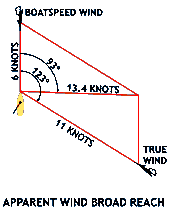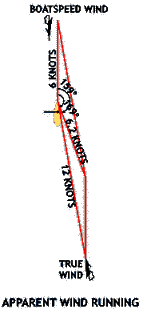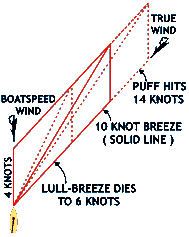Apparent wind is a very simple concept that continues to mystify many people who have been sailing for years. It is the combination of two winds: the one derived by the boat moving through the air and the wind produced by nature—the true wind. Thus, it is the wind you feel on the boat. Cigarette smoke, telltales, and the electronic wind direction indicators of boats all show the apparent-wind direction. We often get the comment from people on their first time out, "You said we sail within 40 degrees of the wind when close-hauled, but the wool on the shrouds indicates we're sailing almost into the wind." This is their first experience with apparent wind on a sailboat. Imagine yourself standing up in a convertible. It is a calm day, so there's no true wind. As the convertible starts forward, you will begin to feel a breeze on your face that increases as the speed of the car increases. At 10 mph you will feel a 10 mph breeze on your face. This is apparent wind. Now imagine yourself in the same car heading north and there's an easterly wind of 10 mph blowing. This nature-produced wind from the east is what we call true wind. It is hitting the right side of your face. As the car starts forward you will not feel two different winds, one on the side and one on the front of your face, but a resultant wind coming from an angle forward of the true wind. What you feel is the apparent wind. Figure 1: A simple parallelogram can help determine the force and direction of apparent wind. By drawing a parallelogram from the boat speed and the true wind, you can determine the force and direction of the apparent wind. (Refer to Figure 1.) Let's say your boat tacks through 80 degrees. That means the true wind is 40 degrees off your bow. If, for example, the boat speed is six knots and the true wind is 12 knots, measure off the units as boatspeed wind and true wind in Figure 1. Then draw a parallelogram, the diagonal of which is the apparent wind. By measuring the length of the diagonal, you can determine the speed in knots of the apparent wind.

Figure 1: A simple parallelogram can help determine the force and direction of apparent wind.
In this example (see Figure 1), the apparent wind (the diagonal) measures 17 knots and bears 27 degrees from your heading versus 40 degrees for the true wind. Notice how the direction of the apparent wind changes with the true wind in the subsequent diagrams. (For the purposes of these diagrams we'll keep true-wind speed and boat speed constant, which would only be the case at different points of sailing if the boats were different sizes.)
Four points are obvious from these diagrams. First, the apparent wind is always forward of the true wind (unless the true wind is dead ahead or astern). Second, as the true wind comes aft, the apparent wind lessens in velocity. Third, when the true wind is well aft, a small change in true-wind direction makes a large change in apparent-wind direction. And fourth, when the boat is on a beam reach or close-hauled, the apparent wind is of greater velocity than the true wind.
The first point is important when considering when to jibe. Since it is desirable to sail at a slight angle to the wind rather than dead downwind, you may not be heading to your desired destination and will have to jibe to reach it. It's important, therefore, to determine the direction of the true wind and the angle your heading is making with it. If you know you are steering 20 degrees from dead downwind on one jibe then you will be on the same point of sail when you are 20 degrees from dead downwind on the other jibe. The point of jibing should come when your destination bears 40 degrees off your bow from your present heading. The key, of course, is determining the direction of the true wind. By glancing at your telltales and at the wind signs on the water—like streaks and ripples—you can judge about how far aft of the apparent wind the true wind is.

Figure 2: Apparent wind is always forward of the true wind.
A more positive way of determining true-wind direction is by heading off momentarily until the apparent wind and the true wind line up, i.e., dead downwind. The difference between the new heading and your former heading, 20 degrees in the example above, when doubled (40 degrees) is the number of degrees through which you'll jibe.
The second point—as the true wind comes aft, the apparent wind speed lessens—is obvious if you have ever seen power boats head downwind. Sometimes they cruise along at the same speed and direction as the true wind. Their exhaust hangs around the boat in an enveloping cloud (one reason we sail!), and the apparent wind is just about zero.

Figure 3: As true wind comes aft, apparent wind speed lessens.
This reduction of the wind speed you feel on the boat and thereby the force of the wind on the sails can lull you into forgetting the difference which becomes evident when you round a mark and start on a beat. You may have started your sailing outing on a run, so you had no idea of the apparent-wind strength on a beat. Or the wind may have increased during the run. Either way you must consider the possibility that you may have to shorten sail on a cruising boat when you come up on a beat, and it is easiest to change jibs while still on the run.
Let's say a boat is going nine knots in a 16-knot breeze. If dead downwind, the apparent wind is the true wind minus the boat speed, or just seven knots. This doesn't feel like much wind and the force on the sails is relatively light. When the boat starts beating, she may slow down to six knots, but the apparent wind increases to almost 21 knots. You would assume that, since the apparent wind is now three times greater than the downwind velocity, it exerts three times the force against the sails. Wrong. The force of the wind quadruples as the velocity doubles (the square of the velocity), so the wind force is nine times greater on the close-hauled course than on the run in this case. Couple this with the increased heeling moment of the close-hauled course, and the boat may very well be overpowered. So you should have the forethought to shorten the sail during the run.
The third point we made about the apparent-wind diagrams was that when the true wind is well aft, a small change in the true-wind direction makes a large change in apparent-wind direction. (Compare Figures 2 and 3 with Figures 4 and 5.) In our example, a 30-degree change in the true-wind direction made a 38-degree change in apparent wind. In comparing Figure 4 with Figure 5, we find that a 16-degree change in the true wind makes a 28-degree change in apparent wind. This, among other things, is what makes steering dead downwind so difficult. A small swing by the lee actually results in an exaggerated swing of the apparent wind by the lee. This can cause oscillation as the apparent wind swings madly back and forth from one side of the boat to the other on relatively minor changes in heading. At worst, it can force an inexperienced helmsman into a flying jibe.


Figures 4 and 5: A small change in the true wind direction makes a large change in apparent wind direction.
The fourth point was that when a boat is reaching or beating, the apparent wind is of greater velocity than the true wind. You are, in effect, "making your own wind." In iceboating this is an important part of the resulting high speeds. Some iceboats, for instance, can reach speeds five to six times the speed of the wind and can attain speeds of 120 knots in 24 knots of wind. The faster the boat goes, the higher the wind velocity it creates. Only because of the lack of friction can these high speeds be attained. A normal sailboat is limited in speed by hull resistance, skin friction, and wave-making drag, so it cannot take full advantage of the increased apparent-wind velocity. A planing sailboat is more apt to get up on a high-speed plane while on a reach rather than a run just because of this apparent-wind increase. Even so, the faster a boat is to windward, the more close-winded (able to head close to the wind) it must be.
In the first set of wind diagrams, everything remains constant except the direction of the true wind, which moves farther aft in each subsequent diagram. Now let us change the boat speed and the wind velocity, keeping the true-wind direction at 45 degrees off the bow.
Notice in Figure 6 that the wind speed was initially 10 knots and the boat speed four knots. The dotted extension of the true wind line indicates a four-knot increase or puff. So we see a basic axiom: "In a puff, the apparent wind comes aft." To be correct, this necessitates a constant speed on the boat's part. Generally, however, by the time the boat picks up speed the puff has passed, so the axiom holds true.

Figure 6: In a puff, the apparent wind comes aft.
We already know that we point higher in order to reduce heeling when hit by an overpowering gust. This axiom shows another reason to do the same thing. As the gust hits, the apparent wind goes aft causing more heeling and less drive and changing the angle of incidence—the angle the apparent wind makes with the sails—so that the sails are now improperly trimmed unless you head up or ease the sheets or traveler. This change in apparent-wind direction is important to remember even on light days. When you have a three-knot breeze, the wind velocity in a puff is apt to be more than double the regular breeze. When it is blowing 15 knots, gusts may get to only 20 or 22 knots, or about a third higher. Thus, the change in apparent-wind direction aft is often greater on light days than on heavy ones.
The dot-dash lines in the diagram show the resulting change in apparent wind when the wind dies suddenly. With the boat speed remaining constant and the wind velocity lowering to six knots, the apparent wind goes forward. This is one of the reasons that small catamarans rarely carry spinnakers. If they do carry a spinnaker, it is a flat, asymmetrical sail much like a reaching genoa. The hulls have very little resistance to the water, and the cats sail downwind almost as fast as the wind, making it very difficult to keep a spinnaker drawing. If the wind dies for a moment, the spinnaker collapses and it is very difficult to get it filled until the boat slows down. Therefore, small cats, much like iceboats, tack downwind by jibing. By sailing from reach to reach, they pick up greater speed and make up the extra distance sailed.
| Contents | 1 | 2 | 3 | 4 | 5 | 6 | 7 | 8 | 9 | 10 | 11 | 12 | 13 | 14 | 15 | 16 | 17 | 18 | 19 |
[Previous Chapter] [Next Chapter]